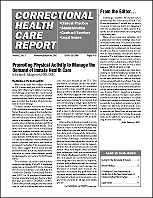Addiction Treatment Behind the Walls
Author: Richard L. Hinchman, M.D..
Source: Volume 04, Number 01, November/December 2002 , pp.3-7(5)

< previous article |next article > |return to table of contents
Abstract:
This is an informative article directed to all who work in correctional health care. If you come in contact with 20 patients in a day in your correctional facility, odds are that 14 to 16 of them have the disease of chemical dependency. Of all the diseases we encounter in our prison populations, chemical dependency is by far the most prevalent, yet as health care practitioners we rarely ever address this with the patient during any of our en counters. It is a myth to assume that be cause the individual is not actively using drugs or alcohol, that his or her chemical dependency is under control. If simply stopping drugs and/or alcohol for a period of time was an effective treatment for this disease, then treatment centers should have a much higher cure rate. Unfortunately, recidivism is the rule rather than the exception. The fact of the matter is that the disease is chronic and progressive. True addiction and alcoholism continue to progress even during long periods of abstinence; and if the patient is not mad e aware of this, his or her chances of relapse to active using after release from prison is extremely high.Keywords: 12-Step, genetic component, Recidivism, Disease vs. Behavioral Problem, segregation
Affiliations:
1: American College of Ob/Gyn.